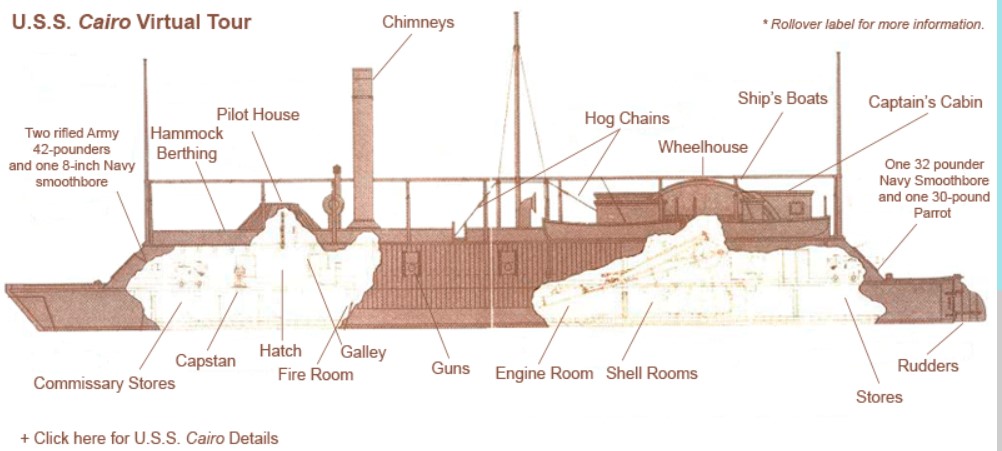ECW Weekender: U.S.S. Cairo at Vicksburg (Virtually)
Let’s head into the Civil War’s western theater from the safety of our digital devices this weekend! Vicksburg National Military Park has created a virtual tour of the USS Cairo, completely with a close up examination of the history and artifacts in the exhibit.
The vessel acted like a time capsule after it sank in the Yazoo River on December 12, 1862. Thankfully, no crew members were lost when the ironclad struck the underwater torpedoes and consequently sank. Mud and river silt preserved the ironclad and its contents until 1964 when it was raised, cataloged, and prepared for display.
There is a lot to explore in this well-crafted, online display. Start clicking, exploring, and learning sometime this weekend.


The Cairo was the first of the Civil War era naval “rescues” I was able to visit. The Monitor and the Hunley came later. On my initial visit to Vicksburg I remember being amazed how at once the vessel was very modern and at the same time truly a 150 year old time capsule.
Just one of many Civil War era “saves” to which we owe distinguished historian Ed Bearrs.
The impression many have of USS Cairo is “bad luck boat.” And that moniker is not undeserved, because from the time she was launched, the Cairo seemed to be everywhere “a day late, and a dollar short.” Ordered back to port for repairs on February 5th, she was unavailable to participate in the Navy’s subjugation of Fort Henry; and during the Fort Donelson operation, USS Cairo was still under repair. Third week of February 1862 Lieutenant Bryant and his Cairo were ordered to take part in a combined gunboat and 13-inch mortar assault on Fort Columbus; but that operation did not eventuate due to a ruse practiced by the Rebel commander at Columbus (who used a flag of truce to buy time and evacuate Fort Columbus.)
USS Cairo next was assigned as escort to General Bull Nelson’s Division aboard a flotilla of seven transports steaming up the Cumberland River to reinforce Grant at Fort Donelson. General Grant no longer needed reinforcements, so Nelson’s Division were ordered “returned to Buell’s Army of the Ohio” and the transports, under escort of USS Cairo continued up river to the open city of Nashville (and General Grant also made the voyage aboard his flagship, the powerful towboat W.H.B. either in company with Nelson’s flotilla, or just a few hours behind.) Bull Nelson arrived at Nashville on the morning of February 25th, stepped ashore, and became the first Federal General to occupy Nashville. And his boss, Brigadier General Buell, was promoted to Major General for occupying Nashville. And during the subsequent three days, Generals Buell and Grant had an unfortunate encounter… but that’s another story.
After departing Nashville, Lieutenant Bryant determined his vessel was still experiencing “engine problems” making the Cairo under-powered. She returned to port for more repairs.
End of March, USS Cairo was assigned to duty on the Tennessee River to support General Grant’s build-up of forces at Pittsburg Landing. She struggled up river, arrived late, and was assigned to William Tecumseh Sherman’s expedition of April 1st (supposedly to try to cut the Memphis and Charleston Railroad; but due to the fact every navigable tributary of the Tennessee River south of Pittsburg Landing was investigated to the head of navigation, the mission may have been an attempt to find and destroy two Rebel steamers rumored to be hidden away, converted into gunboats.) Timberclads USS Tyler and USS Lexington were also part of the expedition; and the Lexington had to tow USS Cairo up river.
USS Cairo returned to Pittsburg Landing on April 2nd and Lieutenant Bryant immediately departed downriver to return to port and seek more repairs… and the Battle of Shiloh erupted just a few days later.
[More details to be found in OR (Navy) Ser.1 vol.22].
Good points. All of the “Pook Turtles” (City Class) were in some ways analogous to the escort carriers turned out for the USN in WW II. They were built in an astonishingly short time, specifically for riverine warfare with light draft; were somewhat underpowered and as slow as all getout (4-5 mph unless aided by strong current); had limited gun arc for firing at elevated positions on land; and although mostly cloaked in sloping casemate had vulnerable areas (stern, aft (IIRC) of plant, etc.)